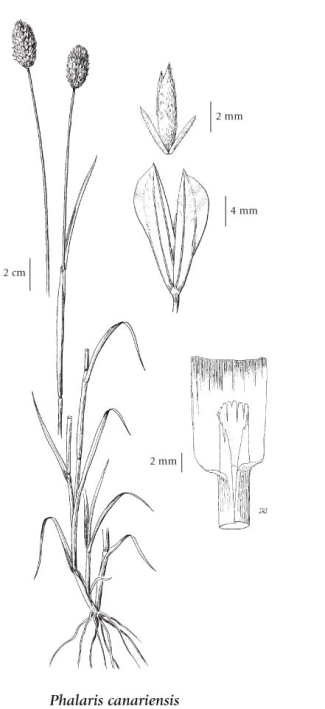Phalaris canariensis L.
canarygrass (annual canarygrass)
Poaceae (Grass family)
Introduction to Vascular Plants
canarygrass (annual canarygrass)
Poaceae (Grass family)
Introduction to Vascular Plants
Species Information
General:
Annual grass from fibrous roots, usually basally-branched; stems 30-60 (100) cm tall.
Leaves:
Sheaths open; blades flat, (3) 4-10 mm wide, the margins somewhat unequally freed from the sheaths; ligules blunt to rounded, usually with deeply irregular, jagged margins, smooth externally, 4-8 mm long; ear-shaped lobes at the leaf-bases occasionally present, scarcely 0.3 mm long.
Flowers:
Inflorescence a dense, egg-shaped to cylindrical panicle, 1.5-3 (4) cm long; spikelets 6-8 mm long; glumes nearly equal, obliquely egg-shaped, with 3 greenish nerves, abruptly short sharp-pointed, strongly winged on the upper halves, the wings about 1 mm wide; sterile lemmas 2, finely hairy, the lower 2.5-3 mm long, the upper 3-3.5 mm long, both nearly 1 mm wide; fertile lemmas finely hairy, abruptly sharp-pointed, 5-5.5 (6) mm long; paleas nearly equal to the lemmas; lodicules absent; anthers 2.5-3 mm long.
Illustration

If more than one illustration is available for a species (e.g., separate illustrations were provided for two subspecies) then links to the separate images will be provided below. Note that individual subspecies or varietal illustrations are not always available.
Illustration Source: The Illustrated Flora of British Columbia
